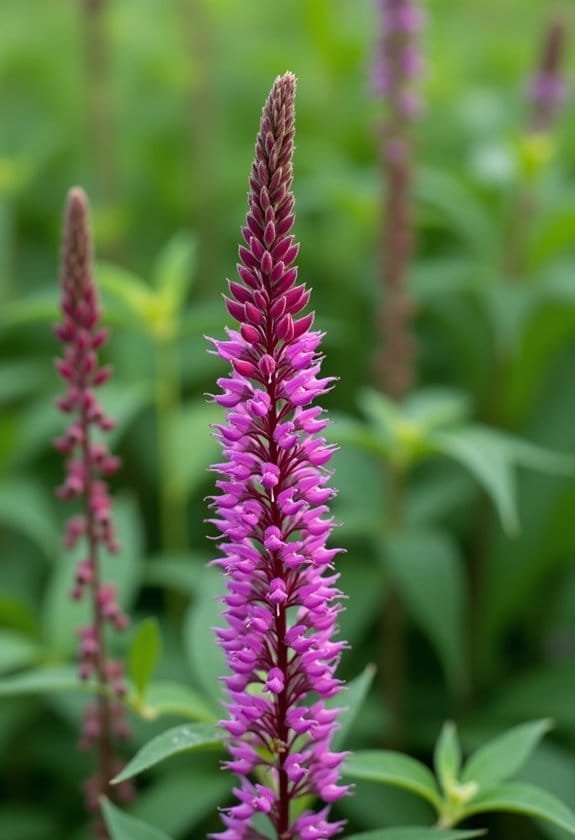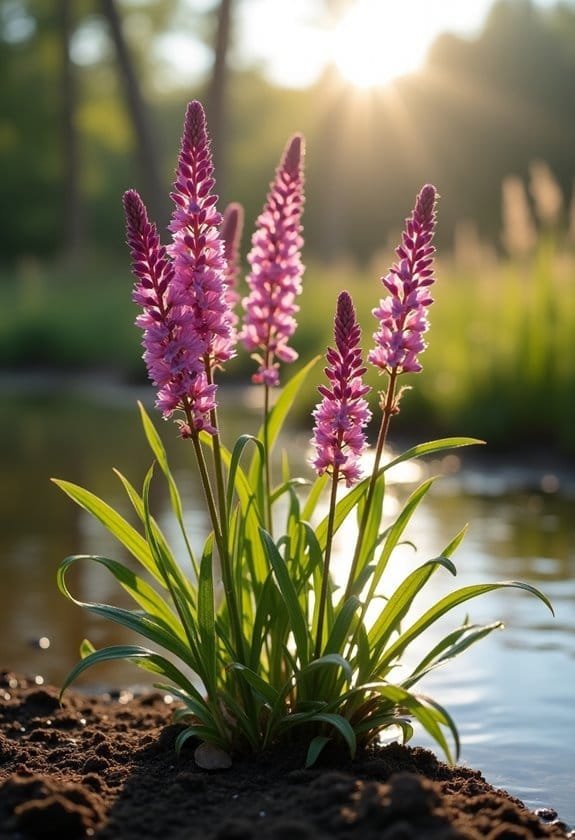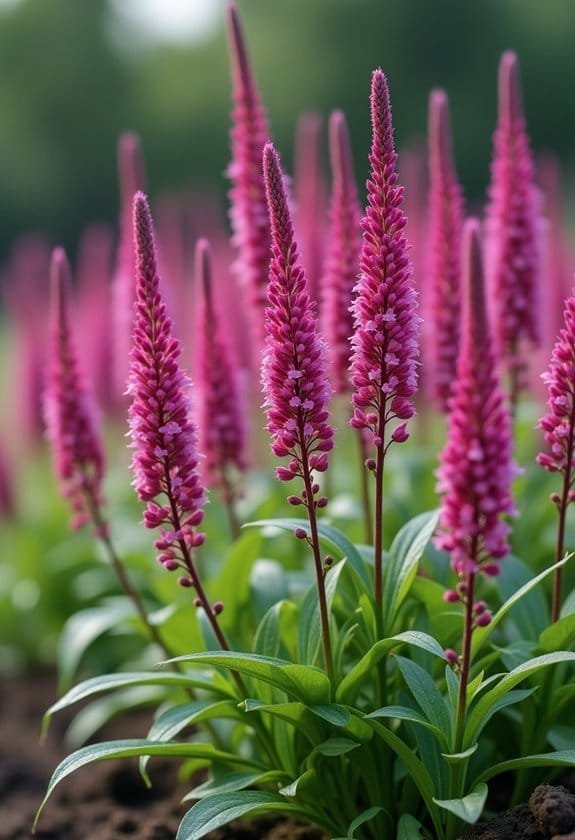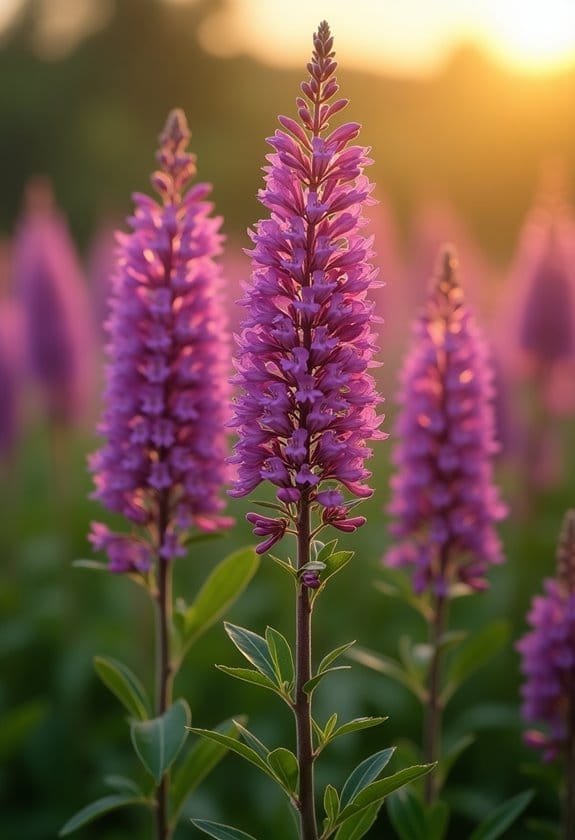Lythrum salicaria, commonly known as purple loosestrife, has earned its reputation as one of North America's most formidable wetland invaders since its 1800s introduction. This Eurasian perennial towers up to 4 meters tall, producing vibrant purple flower spikes that attract pollinators from June through September. It's an aggressive colonizer that can generate over 2 million seeds per season, thriving in full sun and consistently moist soils. While its striking appearance once made it a coveted ornamental plant, purple loosestrife's ability to form dense monocultures has devastated native wetland ecosystems across the continent. Understanding its growth patterns reveals why this beautiful invader demands serious attention.
Main Points
- Purple Loosestrife is an invasive wetland perennial from Eurasia that produces vibrant purple flower spikes and can grow up to 4 meters tall.
- The plant spreads aggressively, producing over 2 million seeds per season and forming dense colonies that outcompete native wetland species.
- It thrives in full sun and wet environments, particularly in marshes and riverbanks, though it can adapt to various soil conditions.
- Flowers bloom from June to September, attracting pollinators like bees and butterflies, while potentially reducing pollination of native species.
- Control methods include mechanical removal, herbicide treatment, and biological control using specific beetles as natural predators.
Introduction

Purple Loosestrife (Lythrum salicaria), a striking wetland perennial native to Eurasia, has become one of North America's most recognizable invasive plants.
Its distinctive purple flower spikes and robust growth habit, reaching heights of up to 4 meters, make it a prominent fixture in marshes, riverbanks, and other wet areas across the continent.
Since its introduction to North American shores in the 1800s through ship ballast and medicinal imports, this aggressive colonizer has established itself in nearly every U.S. state and Canadian province.
It fundamentally alters native wetland ecosystems through its remarkable reproductive capacity and competitive nature.
Common Name
Known widely as Purple Loosestrife, Lythrum salicaria is a towering perennial that showcases vibrant purple flower spikes. This remarkable plant, which can reach impressive heights of up to 4 meters, has earned its common name from both its striking purple blooms and its membership in the loosestrife family, Lythraceae.
The plant's recognition extends across linguistic boundaries, with French speakers referring to it as "Salicaire commune," reflecting its widespread presence in various regions. Its distinctive appearance features clusters of showy flowers, each bearing 5-7 petals, arranged on commanding spikes that can extend up to one foot in length.
While these characteristics make Purple Loosestrife visually appealing, they've also contributed to its status as an aggressive invader in many ecosystems. The designation as a noxious weed, particularly in regions like North Carolina, stems from its robust growth pattern and ability to outcompete native species.
This invasive perennial's remarkable adaptability allows it to establish dominant populations, often reaching heights between 2 to 6 feet in various environmental conditions, making it a significant concern for ecosystem management.
Scientific Name
The scientific name Lythrum salicaria carries rich etymological significance rooted in ancient Greek and Latin. The genus name Lythrum derives from the Greek word "lythron," meaning blood, which aptly describes the plant's vibrant purple-red flower clusters that dot wetland landscapes throughout its range. This classical reference provides insight into how early botanists perceived and classified this striking species.
The species epithet salicaria demonstrates an observant connection to the willow family (Salix), as the plant's leaves bear a remarkable resemblance to those of willow species. This taxonomic designation, formally established by the renowned Swedish botanist Carl Linnaeus during the 18th century, reflects the meticulous nature of historical botanical classification systems.
While Lythrum salicaria belongs to the family Lythraceae, its similarity to willows showcases nature's tendency toward convergent leaf forms. Today, this scientific name has taken on additional significance as researchers and environmental managers track its status as a non-native, invasive species that poses significant challenges to native ecosystems, particularly in North American wetlands where it has established aggressive colonies.
Overview
Standing tall among wetland flora, Lythrum salicaria dominates marshy landscapes across North America with its vibrant purple spikes and aggressive growth patterns. This tenacious perennial plant, commonly known as purple loosestrife, has transformed from an obscure European transplant into one of North America's most concerning invasive species since its introduction in the 1800s.
The plant's remarkable adaptability allows it to flourish in various wet habitats, from marshlands to riverbanks, while also demonstrating resilience in drier conditions.
What makes Lythrum salicaria particularly formidable is its extraordinary reproductive capacity, with a single plant capable of dispersing over two million seeds in one growing season. This prolific seed production has facilitated its rapid colonization of wetland ecosystems across the continent.
As it establishes itself in new territories, purple loosestrife fundamentally alters wetland dynamics by outcompeting native species for resources and space.
The plant's dense growth patterns can greatly modify water flow patterns and reduce habitat availability for indigenous flora and fauna, leading to substantial changes in wetland biodiversity and ecosystem function.
Key Features
Purple Loosestrife stands as a formidable wetland plant, reaching heights between 60 centimeters and 2 meters with its distinctive square, woody stems emerging from a dense rootstock.
The plant's vibrant purple flowers, featuring 5-7 petals, cluster prominently on spikes that stretch 10-40 centimeters above the main structure.
Its lance-shaped leaves, arranged in opposite pairs or whorls along the stems, complement the plant's robust appearance and can extend up to 10 centimeters in length.
Growth Size
Reaching impressive heights of 60 cm to 2 m, Lythrum salicaria dominates wetland areas with its robust, bush-like structure and square-shaped stems. Under ideal conditions, these remarkable purple loosestrife specimens can stretch beyond 4 meters tall, establishing themselves as towering sentinels in their habitat.
The plant's substantial growth pattern is characterized by multiple stems emerging from a dense rootstock, enabling mature plants to form extensive colonial networks. Each stem features distinctive geometrical architecture, typically displaying four to six sides, which contributes to the plant's structural stability as it reaches toward its full height potential.
The flower spikes, measuring 10 to 40 centimeters, crown these impressive stems with vibrant purple blooms.
Adding to its dimensional complexity, the plant produces lance-shaped leaves up to 10 centimeters in length, arranged in opposite or whorled patterns along the stems. This strategic leaf arrangement, combined with the branching growth pattern, creates a visually striking and spatially efficient structure that maximizes the plant's exposure to sunlight while maintaining its commanding presence in wetland ecosystems.
Appearance
The distinctive features of Lythrum salicaria make it one of the most recognizable wetland plants in its range. Purple loosestrife exhibits a robust, bush-like structure characterized by multiple erect stems that can reach impressive heights between 60 centimeters and 2 meters.
The plant's square, woody stems display a striking reddish-purple hue and are adorned with distinctive lance-shaped leaves that grow up to 10 centimeters in length. These smooth-edged leaves arrange themselves either oppositely or in whorls along the hairy, angular stems, creating an organized pattern that enhances the plant's architectural presence.
The most enchanting aspect of purple loosestrife is its showy purple flowers, which cluster dramatically on tall spikes reaching 10-40 centimeters. Each flower showcases 5 to 7 delicate petals measuring 7-10 millimeters, creating dense, vibrant displays that dominate wetland landscapes during blooming periods.
These floral spikes serve as more than mere decoration, housing countless tiny seed capsules that each measure less than a millimeter, ultimately contributing to the plant's remarkable reproductive capacity of over 2 million seeds per growing season.
Flowering Season
Summer wetlands burst into vibrant displays as Lythrum salicaria flowers emerge from mid-June through late September, with peak blooming occurring in July and August.
During this vital flowering season, the plant produces striking purple blossoms arranged in dense spikes that stretch 10-40 centimeters skyward, each flower sporting 5-7 delicate petals.
The flowering period represents a vital phase in the plant's lifecycle, attracting numerous long-tongued pollinators essential for successful reproduction.
Bees and butterflies, drawn to the vibrant purple spikes, facilitate extensive pollination throughout the summer months, enabling this invasive plant to achieve remarkable seed production capabilities.
Each mature specimen can generate an astounding two million seeds during a single flowering season, contributing considerably to its aggressive spread across wetland ecosystems.
As autumn approaches and the flowering season concludes, the plant enters its seed dispersal phase.
Throughout fall and winter, millions of tiny seeds are released from their capsules, carried by wind and water to colonize new territories, ensuring the continued expansion of this remarkably prolific species.
Growing Requirements

Purple loosestrife demonstrates remarkable adaptability in its growing requirements, thriving in full sun while tolerating partial shade across various habitat types.
The plant flourishes in consistently moist to wet soils typically found in marshlands and along waterways, though its resilient nature allows it to establish itself in drier conditions when necessary.
Its temperature tolerance and hardy rootstock enable it to survive in diverse climatic zones, making it a particularly successful colonizer in temperate regions where seasonal variations occur.
Light
Growing ideally in full sun, Lythrum salicaria demonstrates remarkable adaptability by also tolerating partial shade conditions. This versatile wetland species maximizes its photosynthetic potential in locations receiving direct sunlight, where it typically achieves its most robust growth and prolific flowering patterns.
The plant's sophisticated response to light conditions directly influences its colonization strategy in various wetland environments. In full sun exposure, purple loosestrife can reach impressive heights exceeding 2 meters, developing dense, bush-like formations that effectively capture available light.
Its ability to thrive in partial shade enables the species to establish itself under varying canopy conditions, though growth may be somewhat less vigorous than in full sun locations.
This light adaptability, combined with the plant's specialized stem tissue for underwater respiration, creates a formidable competitor in wetland ecosystems. When favorable light conditions align with wet soil environments, purple loosestrife begins its flowering cycle in mid-June, producing striking purple blooms that can dominate the landscape and potentially overshadow neighboring vegetation through its aggressive growth pattern.
Soil
The adaptable nature of Lythrum salicaria shines through in its soil preferences, as it puts down roots in both consistently wet and occasionally dry conditions. This versatile plant particularly thrives in the saturated soils of marshes, riverbanks, and lakeshores, where its specialized stem tissues enable survival even during periodic flooding.
The plant's relationship with soil moisture proves especially significant during its reproductive phase, as ideal germination occurs in warm, water-rich environments. Its extensive root systems demonstrate remarkable engineering capabilities, actively modifying their surroundings by capturing sediments and gradually raising local water tables.
This soil manipulation creates conditions that further favor the species' establishment and spread throughout wetland ecosystems. As these dense networks of roots continue to develop, they progressively alter the soil structure and hydrology of invaded areas, creating a self-reinforcing cycle that enhances the plant's dominance.
While wet habitats remain its preferred environment, purple loosestrife's ability to establish itself in drier soils showcases its exceptional adaptability and explains its success as an invasive species across diverse landscapes.
Water
Water plays a central role in Lythrum salicaria's growth requirements, reflecting its natural affinity for wetland environments. The plant demonstrates remarkable adaptability to various moisture conditions, thriving particularly in marshes, lakesides, riverbanks, and water-filled ditches.
Its specialized stem tissue enables survival in submerged conditions through efficient respiration mechanisms, making it exceptionally well-suited to flooded environments.
Purple loosestrife's relationship with water extends beyond mere survival, as its dense root systems actively modify wetland hydrology. By trapping sediments and influencing water table levels, these extensive root networks can fundamentally alter the characteristics of their aquatic habitats.
The plant's seeds exhibit ideal germination in wet, warm conditions, and can successfully sprout even when completely submerged in standing water.
While purple loosestrife shows a clear preference for consistently moist environments, it's essential to highlight that the species demonstrates considerable resilience, capable of establishing itself in relatively drier soils when necessary.
This adaptability, combined with its ability to modify water flow patterns, contributes greatly to its success in diverse aquatic ecosystems.
Temperature
Temperature requirements for Lythrum salicaria complement its moisture preferences, creating ideal conditions for robust growth and reproduction. The plant demonstrates remarkable success in warm environments, particularly when soil temperatures exceed 20°C (68°F), which promotes optimal germination in its preferred wet habitats.
While purple loosestrife exhibits adaptability across various temperature ranges, it flourishes most vigorously under full sun exposure and sustained summer heat. The plant's growth cycle responds dynamically to seasonal temperature fluctuations, with flowering initiation typically occurring in mid-June and extending throughout the warmer months.
During peak summer temperatures, the plant reaches its maximum reproductive potential and biomass production. Although capable of persisting in cooler conditions, purple loosestrife's health diminishes considerably when temperatures fall below 10°C (50°F), affecting both its growth rate and reproductive capabilities.
The plant's temperature requirements align naturally with its affinity for moisture-rich environments, as these areas often maintain the warmth necessary for sustained growth. This temperature-moisture relationship explains why the species typically dominates wetland ecosystems where both conditions converge favorably.
Pollinator Criteria
Purple loosestrife's vibrant flower clusters serve as powerful magnets for long-tongued pollinators, particularly bees and butterflies seeking its abundant nectar reserves.
The plant's reproductive success relies heavily on these winged visitors, who transfer pollen between the strategically positioned stamens and pistils during their nectar-gathering missions from late June through early September.
Through this cross-pollination process, a single purple loosestrife plant can generate thousands of viable seeds, though its overwhelming attractiveness to pollinators often creates competition with neighboring native species.
Attracted Pollinators
Throughout the summer months, Lythrum salicaria's vibrant flowers attract an array of pollinators, particularly long-tongued insects like bees and butterflies. The plant's distinctive six-petaled blooms serve as abundant nectar stations, offering these essential pollinators a rich source of sustenance during their most active period.
These pollinator interactions play an important role in the species' reproductive success, facilitating cross-pollination that enhances genetic diversity within purple loosestrife populations.
While the plant's ability to attract and sustain pollinator populations might seem beneficial, its invasive nature presents a complex ecological challenge in wetland environments.
The relationship between purple loosestrife and its pollinators illustrates a delicate balance in ecosystem dynamics. As these plants establish dense colonies in wetland areas, they can overshadow native plants and monopolize pollinator attention.
This competitive advantage often results in reduced pollination success for indigenous species, potentially disrupting established pollinator networks. Despite providing temporary habitat and nectar resources for various pollinating insects, purple loosestrife's overwhelming presence can ultimately lead to decreased biodiversity in affected wetland communities.
Pollination Method
The pollination process of Lythrum salicaria relies primarily on long-tongued insects, with bees and butterflies serving as the main pollinators during the summer flowering season. These specialized pollinators are particularly well-suited to access the plant's nectar through its distinctive flower structure, which features 5-7 petals arranged to facilitate cross-pollination.
During ideal conditions, typically on warm, sunny days, visiting pollinators navigate through the numerous stamens while collecting nectar, inadvertently transferring pollen between plants. The flower's architecture promotes effective cross-pollination, as the positioning of reproductive structures maximizes contact with the insects' bodies during their foraging activities.
This efficient pollination mechanism contributes to the plant's remarkable reproductive success, enabling it to produce millions of seeds per season.
However, the plant's exceptional pollination efficiency can create ecological challenges, as dense stands of purple loosestrife often monopolize pollinator attention. This dominance in the pollination landscape can considerably impact native plant species, which may struggle to maintain sufficient pollinator visits for their own reproduction when competing with these aggressive colonizers.
Care & Maintenance

The cultivation of Lythrum salicaria requires careful attention to light conditions, with ideal growth achieved in full sun or partial shade environments.
Successful maintenance demands vigilant monitoring during the flowering period from mid-June through early August, coupled with strategic removal of flower stalks to prevent unwanted spread.
When establishing purple loosestrife in a garden setting, it's crucial to pair it with robust companion plants that can withstand competition, while implementing a thorough management strategy that may include mechanical removal, herbicide application, or biological control methods.
Planting Tips
Successful cultivation of purple loosestrife demands careful attention to location and ongoing maintenance. When selecting a planting site, opt for areas receiving full sun to partial shade, where the soil remains consistently moist to support this moisture-loving plant's robust growth requirements.
While purple loosestrife's adaptability makes it an appealing landscaping choice, its invasive nature necessitates thoughtful control measures. The plant's impressive height potential of 2 meters requires strategic spacing to accommodate its eventual spread and extensive root system.
Given its aggressive growth patterns, implementing strict control of purple loosestrife becomes essential through regular monitoring and maintenance during the flowering period of July and August. Gardeners should promptly remove flower stalks before seed formation, as a single plant can release millions of seeds into the environment.
For those considering ornamental cultivation, sterile cultivars offer a seemingly safer alternative, though they still pose risks through potential cross-pollination with wild varieties. Conservation-minded gardeners might instead explore native plant alternatives that provide similar aesthetic appeal without threatening local ecosystem balance.
Ongoing Care
Maintaining purple loosestrife requires vigilant monitoring and consistent intervention throughout its growing season. Success in controlling this invasive species hinges on early detection and swift response, particularly during the critical flowering period from June through early August.
Regular monitoring becomes especially important in early summer when the distinctive purple blooms begin to appear. At this stage, mechanical removal techniques prove most effective, including carefully hand-pulling plants or cutting flower stalks before they can produce and disperse seeds.
It's vital to properly dispose of all removed plant material by sealing it in plastic bags, preventing inadvertent spread to new locations. The ongoing care strategy must include systematic checks of previously infested areas to catch and manage any persistent regrowth.
For more challenging infestations, chemical control methods using glyphosate or triclopyr may be necessary, though these should be applied with precision to protect neighboring native vegetation.
This integrated approach to management guarantees that native plant communities have the opportunity to reestablish themselves in areas where purple loosestrife once dominated, creating a more balanced ecosystem.
Suggested Companions
When planting alongside Lythrum salicaria, gardeners must carefully select companions that can withstand its aggressive growth habits and similar moisture requirements. Native wetland species prove to be particularly successful companions, with Schoenoplectus tabernaemontani and Typha latifolia demonstrating remarkable resilience against purple loosestrife's competitive nature.
For ideal compatibility, Echinacea purpurea can thrive alongside Lythrum salicaria when proper maintenance practices are implemented. Strategic spacing between plants, coupled with regular post-flowering pruning of the loosestrife, creates a balanced environment where both species can flourish. A thorough mulching strategy helps regulate moisture distribution and minimize resource competition among the planted specimens.
Successful companion planting requires vigilant monitoring of plant interactions, as Lythrum's vigorous root system and dense growth pattern can potentially overwhelm less robust species.
Gardeners should observe their plantings regularly, looking for signs of stress or suppression in companion plants. This careful attention to plant dynamics, combined with appropriate species selection and proactive maintenance, guarantees a harmonious wetland garden where both Lythrum salicaria and its companions can thrive sustainably.
Common Issues
While purple loosestrife generally maintains robust health in various conditions, its aggressive growth patterns make it a significant ecological pest that threatens native wetland species.
The plant's remarkable resilience means it rarely suffers from conventional garden diseases or insect problems, though leaf-eating beetles like Galerucella calmariensis can be introduced as biological control agents.
Management solutions typically involve a combination of manual removal for small infestations, carefully timed herbicide applications for larger stands, and the strategic release of approved biological control insects to reduce population density.
Pests/Diseases
The vulnerability of purple loosestrife to insect pests makes it a prime target for biological control efforts. Two species of leaf beetles, Galerucella calmariensis and Galerucella pusilla, have emerged as particularly effective agents, systematically consuming the plant's foliage and greatly diminishing its growth potential. These natural predators serve as a cornerstone in managing this aggressive invasive plant.
The plant's defense mechanisms face additional challenges from specialized root-feeding insects, particularly the Hylobius transversovittatus weevil, which launches underground attacks on the root system.
Meanwhile, the strategic seed predation by Nanophyes marmoratus weevils disrupts the plant's reproductive cycle by targeting its flowers before seed formation can occur. The Ectropis crepuscularia moth's caterpillars further contribute to the plant's stress through persistent defoliation.
While purple loosestrife demonstrates remarkable resilience against diseases, its susceptibility to these insect species has made it possible to implement successful biological control programs, ultimately helping to preserve native plant diversity and maintain healthier ecosystems.
Solutions
Managing purple loosestrife infestations calls for a multi-pronged approach tailored to the scale of the problem. Native to Europe, this invasive plant requires strategic intervention through various control methods, with monitoring and early detection serving as essential first steps in preventing its spread.
For small-scale invasions, mechanical weed control methods prove most effective, including careful hand-digging and removing flower stalks before they can produce their prolific seeds.
Larger infestations demand more aggressive measures, with targeted applications of glyphosate or triclopyr herbicides showing significant success when applied by trained professionals.
The biological control of purple loosestrife has emerged as a promising long-term strategy, particularly through the introduction of specialized beetle species that naturally regulate the plant's growth and reproduction. These beneficial insects, including Galerucella calmariensis and Galerucella pusilla, specifically target purple loosestrife while leaving native species unharmed.
Prevention remains equally important, with proper equipment cleaning and careful disposal of plant materials helping to contain existing populations and prevent new invasions from taking root in vulnerable ecosystems.
Summary

Purple loosestrife (Lythrum salicaria) poses a significant threat to wetland ecosystems across North America since its introduction in the 1800s. This invasive plant's remarkable reproductive capacity, producing over 2 million seeds per season, has enabled its rapid spread throughout Canada and most U.S. states, where it aggressively outcompetes native species for resources and space.
The plant's distinctive features, including its vibrant purple flowers and woody square stems, belie its destructive nature in wetland environments. Like an unwanted architect, purple loosestrife redesigns wetland landscapes by trapping sediments and altering natural water flow patterns, while simultaneously reducing biodiversity and disrupting essential ecosystem services.
The ecological impacts extend beyond immediate vegetation concerns, affecting wildlife habitat quality and disturbing natural nutrient cycles.
While various control methods have been developed, including mechanical removal, herbicide application, and biological control through specialized beetles, the plant continues to present management challenges. Its persistent nature and widespread distribution serve as a sobering reminder of how introduced species can fundamentally transform native ecosystems, leading to both ecological and economic consequences.


